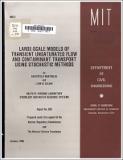| dc.contributor.author | Mantoglou, Aristotelis | en_US |
| dc.contributor.author | Gelhar, Lynn W. | en_US |
| dc.date.accessioned | 2022-06-13T13:11:43Z | |
| dc.date.available | 2022-06-13T13:11:43Z | |
| dc.date.issued | 1985-01 | |
| dc.identifier | 299 | |
| dc.identifier.uri | https://hdl.handle.net/1721.1/143040 | |
| dc.description | This research was supported in part by the U.S. Nuclear Regulatory Commission, Contract No. NRC-04-83-174. This research was supported in part by the National Science Foundation , Grant No. CEE-8311786. | en_US |
| dc.description.abstract | A new framework for modeling large-scale unsaturated flow and solute transport systems in spatially variable soils is proposed. The largescale model structures are derived by averaging the local governing flow and transport equations over the ensemble of realizations of the underlying soil property random fields. The resulting mean representations are in the form of partial differential equations in which averaged or effective model parameters occur. These effective model parameters, i.e., effective hydraulic conductivity, effective specific moisture capacity and effective macro-dispersivity, are evaluated using a quasi-linearized fluctuation equation and a spectral representation of stationary processes. The large-scale model structures consider the large-scale effects of soil variability and have relatively flw parameters identifiable from a realistic data set. The effective parameters are analytically evaluated in particular cases of practical interest, and generic expressions showing explicitly the dependence of the effective parameters on the different flow, transport and soil property characteristics are derived. General methods for testing the validity of the stochastic theory and application of the large-scale models in practical situations are suggested. The spectral turning bands method developed by Mantoglou and Wilson (1981, 1982) is extended for digital generation of point values or spatial averages of multiple, cross-correlated, stationary random fields. Statistical inference methods are discussed and a new identification method is presented. The most important findings of this study are that spatial variability of the hydraulic soil properties produces significant large-scale effects. In particular, it was found that the effective hydraulic conductivity, the mean soil moisture content and the effective specific soil moisture capacity show significant hysteresis, and that the effective hydraulic conductivity is anisotropic with a degree of anisotropy depending on the mean flow conditions (wetting or drying). It was also found that in the case of unsaturated flow, the effective macrodispersivities depend on the soil moisture content, the type of soil stratification and the direction for the mean flow relative to stratification and the direction for the mean flow relative to stratification. The longitudinal macrodispersivity predicted from the stochastic theory is found to be of the same order of magnitude as observed in large-scale field experiments. The transient unsaturated flow and steady transport results of this study were previously unknown, have important practical implications, and should be considered in field applications such as waste disposal control. The general stochastic modeling framework and the simulation and identification methods developed here are applicable not only to unsaturated flow and transport but also to other distributed parameter systems. | en_US |
| dc.publisher | Cambridge, MA. : Dept. of Civil Engineering, Massachusetts Institute of Technology | |
| dc.relation.ispartofseries | R (Massachusetts Institute of Technology. Department of Civil Engineering) ; 85-2. | |
| dc.relation.ispartofseries | Report (Ralph M. Parsons Laboratory for Water Resources and Hydrodynamics) ; 299. | |
| dc.relation.uri | https://hdl.handle.net/1721.1/15433 | |
| dc.title | Large-scale Models of Transient Unsaturated Flow and Contaminant Transport Using Stochastic Methods | en_US |
| dc.identifier.oclc | 13486017 | |
| dc.identifier.aleph | 241521 | |
